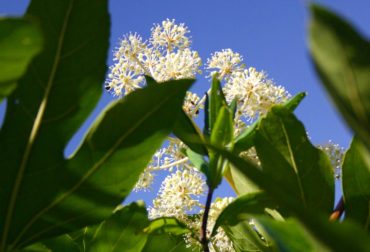
For a shrub that looks like it belongs in the tropics, Fatsias are surprisingly hardy in our region. The plant provides spectacular foliar effects to the West Sound garden, whether it is a plain green-leaf species or one of the variegated cultivars. It’s commonly named Japanese aralia, castor-oil plant or Japanese fatsia, but most people refer to it by its botanical name — Fatsia. The woodland genus originally comes from Japan and South Korea. Two centuries have passed since this shrub first found favor in gardens outside its native region.
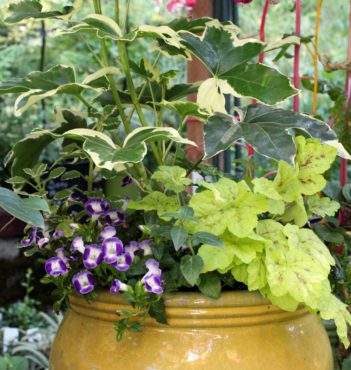
There is something grand about a big-leaf plant. Fatsias are not demure plants in the garden — their presence refuses to shrink into the background. Adding bold, palmately lobed, shiny leaves to the garden brings an architectural structure that begs for attention.
The large (6 to 14 inches across), exotic green leaves are striking with seven to nine lobes (sometimes up to 11 lobes) that create a dramatic contrast when paired with other finer-leafed plants. Select a variegated variety and you create a yearlong, evergreen feast for the eyes. Adding a Fatsia can beef up many a garden design.
Ultimately, the shrub effortlessly grows 15 to 18 feet tall and the canopy becomes more open as it matures. Some gardeners don’t mind the straggly look, while others prefer to cut it back in spring to within a foot off the ground when it becomes too leggy. The Fatsia quickly regrows and becomes more bush-like again with fresh, new foliage. Afterward, prune in spring to maintain a height of about 6 feet.
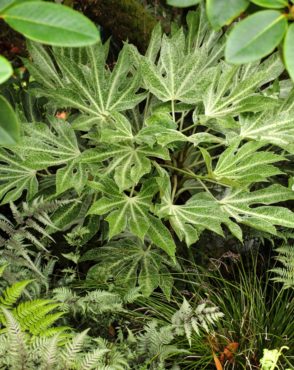
Pair your big, dramatic-leaf plants with the finery of ferns such as maidenhair ferns (Adiantum pedatum) that will happily grow under the shaded canopy of a Fatsia. Other plants that pair up splendidly are black mondo grass (Ophiopogon planiscapus ‘Nigrescens’), mayapple (Podophyllum versipelle ‘Spotty Dotty’) and golden Japanese sedum (Sedum makinoi ‘Ogon’).
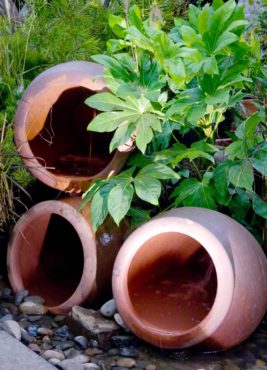
Fatsias bring height and architectural components to outdoor containers. Consider it a thriller plant for those who follow the thriller-spiller-filler container concept. However, Fatsias are charming when used as a stand-alone in a container.
If you have room inside your home for one, Fatsias are excellent decorative houseplants. They tolerate poor-light and low-humidity conditions inside our homes. Historically, the plants have been a popular houseplant for over 100 years.
There is no need to coddle these tough plants. Fatsia will thrive when placed in the east-, south- or west-facing windows. Water the container when the soil is almost dry during the growing season.
If you use air conditioning, you need to provide some extra humidity for your plants, because it dries the air. During the winter, water the plants less often, and only hydrate enough to keep the soil from drying out completely.
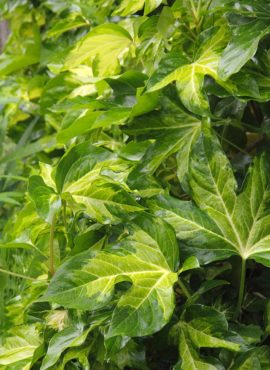
You can grow Fatsia exclusively indoors or place in a shade or partial-shade position during the warm season, and bring it indoors for winter. Before the weather turns cold and you turn on the heaters inside, bring the plant in and cut back on watering. Move it back out to a shady area for the summer after the weather warms.
There are cultivars of note, mainly variegated forms. Fatsia ‘Aurea,’ ‘Annelise’ and ‘Golden Handshake’ may all be the same cultivar with golden-variegated leaves and green, irregular margins. ‘Spider Web’ is a newer introduction. Its new leaves have exciting, web-like markings. ‘Variegata’ has white variegation, mostly at the end of the lobes. A more compact form, ‘Moseri’ has larger leaves.
Tree ivy (x Fatshedera lizei) is an intergeneric hybrid that is an offspring to Fatsia japonica and the dreaded English ivy Hedera helix. Even though it looks like an ivy on steroids, this plant does not spread or climb like ivy. It has become a popular foliage plant for Northwest gardeners. Being a lanky shrub, it tends to sprawl; however, most gardeners prefer the outstanding foliage be the center of attention, so they tie it up against a fence or a wall, where it can grow up to 8 feet tall.
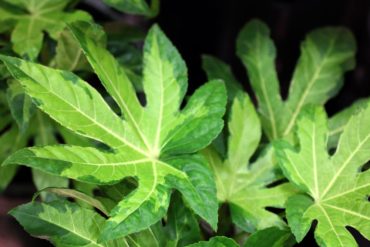
The x Fatshedera has semi-deciduous, deep-lobed, maple-like leaves. New growth suffers some damage when temperatures go below 20 degrees and old growth suffers below 15. When the thermometer dips below 10 degrees, x Fatshedera is killed to the ground. However, the plant readily resprouts. Hard frosts with temperatures in the upper 20s will not damage the foliage during milder winters.
Some exciting cultivars include x Fashedera lizei ‘Variegata’ with green-leaf centers and white margins. ‘Aurea Maculata’ has glossy leaves up to 10 inches wide on red stems. Leaves are green, with lighter green-to-white, irregular blotches in the center.
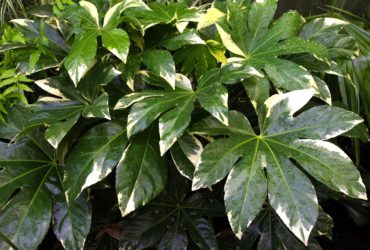
The plants are sometimes labeled under the following names:
- x Fatshedera lizei ‘Anna Mikkels’
- x Fatshedera lizei ‘Lemon Lime’
- x Fatshedera ‘Aureomaculata’
- x Fatshedera ‘Aureovariegata’
- x Fatshedera lizei ‘Mediopicta’
- x Fatshedera lizei ‘Media-Picta’
- x Fatshedera lizei ‘Aureo Picta’
- Annemieke tree ivy
Fatsia Care
Pronunciation:
- Fatsia japonica — FETS-see-uh juh-PAWN-ih-cuh
- Fatshedera lizei — FETS-he-der-uh lih-ZAY
- Fatsias grow in full shade to partial sun. The shrub prefers acidic, moist soil. During the annual summer drought, water the plants deeply once a week. Mulch annually with compost or fine bark.
- When the danger of frost is over in the spring, fertilize shrubs starting with a balanced fertilizer. Follow the directions of your favorite fertilizer for timing and quantity. Do not fertilize after July, to discourage any late-season, new growth, giving the shrub time to harden off before the colder weather sets in.
- The plants are relatively pest free.





























